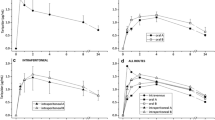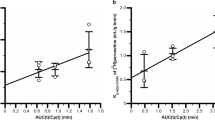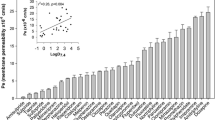Abstract
Purpose
Vincamine, vinpocetine and eburnamonine are alkaloids known for their neuroprotective attributes, enhancement of cerebrovascular blood flow and antitumor effect of their derivatives. However, the relative metabolic stability of these alkaloids and their extrusion by the drug efflux transporters expressed at the blood–brain barrier (BBB) are not clear. In this study, we developed rapid and sensitive methods for the detection of these alkaloids and investigated their relative metabolic stability and their interaction with drug efflux transporters.
Methods
UPLC methods were developed to analyze metabolic in vitro samples. Intrinsic clearance was determined using rat liver microsomal enzymes. Drug-stimulated transporter activity was estimated by measuring inorganic phosphate released from ATP spectrophotometrically.
Results
The UPLC methods quantification level ranged from 0.02 to 0.025 µg/mL, indicating high sensitivity. The intrinsic clearance of eburnamonine was significantly less than both vincamine and vinpocetine. Different concentrations of the three drugs (4, 20 and 100 µM) induced minimal stimulation of the ATPase activity of the Bcrp and Pgp membrane transporters.
Conclusions
The developed simple, sensitive and reliable UPLC analysis methods can be utilized in future in vitro and in vivo studies. The three alkaloids demonstrated minimal interaction with the drug efflux transporters Pgp and Bcrp, concordant with the ability of these alkaloids to cross the BBB. The relative metabolic stability of eburnamonine compared to the other alkaloids suggests the use of eburnamonine or its derivatives as lead compounds for the development of antitumor and nootropic agents that need to cross the BBB and produce their pharmacological effects in the CNS.




Similar content being viewed by others
References
Newman DJ, Cragg GM (2012) Natural products as sources of new drugs over the 30 year from 1981 to 2010. J Nat Prod 75:311–335
Vas A, Gulyas B (2005) Eburnamine derivatives and the brain. Med Res Rev 25:737–757
Woods JR, Riofski MV, Zheng MM, O’Banion MA, Mo H, Kirshner J, Colby DA (2013) Synthesis of 15-methylene-eburnamonine from (+)-vincamine, evaluation of anticancer activity, and investigation of mechanism of action by quantitative NMR. Bioorg Med Chem Lett 23:5865–5869
Fischhof PK, Möslinger GR, Herrmann WM, Friedmann A, Russmann DL (1996) Therapeutic efficacy of vincamine in dementia. Neuropsychobiology 34:29–35
Patyar S, Prakash A, Modi M, Medhi B (2011) Role of vinpocetine in cerebrovascular diseases. Pharmacol Rep 63:618–628
Stolc S (1999) Indole derivatives as neuroprotectants. Life Sci 65:1943–1950
Jeona KI, Xu X, Aizawa T, Lim JH, Jono H, Kwon DS, Abe J, Berk BC, Li JD, Yan C (2010) Vinpocetine inhibits NF-κB-dependent inflammation via an IKK-dependent but PDE-independent mechanism. Proc Natl Acad Sci 107:9795–9800
Mason CW, Hassan HE, Kim KP, Cao J, Eddington ND, Newman AH, Voulalas PJ (2010) Characterization of the transport, metabolism, and pharmacokinetics of the dopamine D3 receptor-selective fluorenyl- and 2-pyridylphenyl amides developed for treatment of psychostimulant abuse. J Pharmacol Exp Ther 333:854–864
Hassan HE, Myers AL, Coop A, Eddington ND (2009) Differential involvement of P-glycoprotein (ABCB1) in permeability, tissue distribution, and antinociceptive activity of methadone, buprenorphine, and diprenorphine: in vitro and In vivo evaluation. J Pharm Sci 98:4928–4940
Teksin ZS, Lee IJ, Nemieboka NN, Othman AA, Upreti VV, Syed SS, Hassan HE, Prisinzano TE, Eddington ND (2009) Evaluation of the transport, in vitro metabolism and pharmacokinetics of Salvinorin A, a potent hallucinogen. Eur J Pharm Biopharm 72:471–477
Shehata MA, El Sayed MA, El Tarras MF, El Bardicy MG (2005) Stability-indicating methods for determination of vincamine in presence of its degradation product. J Pharm Biomed Anal 38:72–78
Dal Bo L, Ceriani G, Broccali G (1992) Determination of vincamine in human plasma by high-performance liquid chromatography with ultraviolet detection. J Chromatogr 573:158–162
El-Gindy A, Emara S, Mesbah MK, Hadad GM (2005) Spectrophotometric and liquid chromatographic determination of fenofibrate and vinpocetine and their hydrolysis products. Farmaco 60:425–438
Shen S, Zhang W (2010) ABC transporters and drug efflux at the blood–brain barrier. Rev Neurosci 21:29–53
Begley DJ (2004) ABC transporters and the blood–brain barrier. Curr Pharm Des 10:1295–1312
Juan YP, Tsai TH (2005) Measurement and pharmacokinetics of vincamine in rat blood and brain using microdialysis. J Chromatogr A 1088:146–151
Vigano V, Paracchini S, Piacenza G, Pesce E (1978) Metabolism of vincamine in the rat. Farmco Sci 33:583–594
Vereczkey L, Szentirmay Z, Szporny L (1979) Kinetic metabolism of vinpocetine in the rat. Arzneimittelforschung 29:953–956
Nyakas C, Felszeghy K, Szabó R, Keijser JN, Luiten PG, Szombathelyi Z, Tihanyi K (2009) Neuroprotective effects of vinpocetine and its major metabolite cis-apovincaminic acid on NMDA-induced neurotoxicity in a rat entorhinal cortex lesion model. CNS Neurosci Ther 15:89–99
Linee P, Hollands MA, Quiniou P, Gueguen M, Le Polles JB (1981) Experimental approach of activity and mechanism(s) of action of drugs used in cerebral metabolic insufficiency. Eur Neurol 20:253–257
Jansen W, O’Connolly M, Lehmann E, Mayer M (1986) Experimental clinical studies on the effect of eburnamonine in cerebrovascular disorders. Pharmacopsychiatry 19:389–394
Drago F, Grassi M, Valerio C, Spadaro F, D’Agata V, Lauria N (1990) Effects of vinburnine on experimental models of learning and memory impairments. Pharmacol Biochem Behav 37:53–57
Louajri A, Harraga S, Toubin G, Kantelip JP (1999) Red blood cell metabolism and hemoglobin oxygen affinity. Effect of vinburnine on normobaric hypoxic rats. Biol Pharm Bull 22:773–774
Maksaya G, Biro T, Kiss B (2004) Vinburnine decelerates [3H]N-methylscopolamine binding to recombinant human muscarinic M1–M4 acetylcholine receptors. Eur J Pharmacol 483:229–232
Jakubik J, Bacáková L, El-Fakahany EE, Tuček S (1997) Positive cooperativity of acetylcholine and other agonists with allosteric ligands on muscarinic acetylcholine receptors. Mol Pharmacol 52:172–179
Author information
Authors and Affiliations
Corresponding author
Ethics declarations
Conflict of interest
None.
Additional information
Tamer E. Fandy and Inas Abdallah have contributed equally to the study.
Rights and permissions
About this article
Cite this article
Fandy, T.E., Abdallah, I., Khayat, M. et al. In vitro characterization of transport and metabolism of the alkaloids: vincamine, vinpocetine and eburnamonine . Cancer Chemother Pharmacol 77, 259–267 (2016). https://doi.org/10.1007/s00280-015-2924-3
Received:
Accepted:
Published:
Issue Date:
DOI: https://doi.org/10.1007/s00280-015-2924-3




